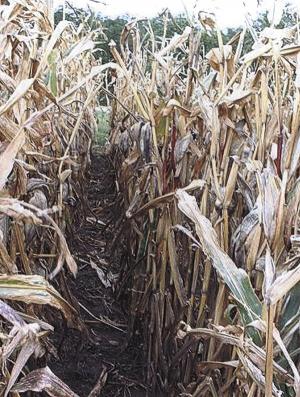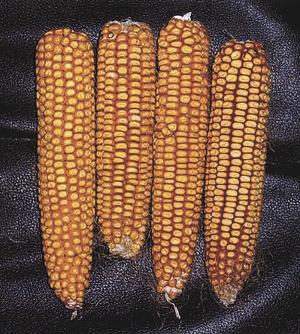New Open Pollinated Corn
For 20 years Glenn Page has been cross breeding and selecting lines of open pollinated (OP) corn for early maturity, standability and yield. He now has three lines ready for commercial sales and another that's close. All he needs is a few people ready to pick up his work and move it into production.
"OP corn cuts drying costs, yields well on marginal ground, and slashes seed costs," says Page. "I have two 85-day or less varieties, a 90-day or more variety, and two early 85-day mid rib varieties," says Page. "They're easily capable of 150 bushel per acre yields and have excellent standability."
Early maturity and spike tassels are two key traits of Page's corn lines. The early maturity utilizes light during the longest days of the season for maximum growth. Early pollen and silk production reduces the potential for yield-limiting plant stress from midsummer heat and drought. The early maturity also reduces drying costs.
"Traditional open pollinated corn had very large tassels producing over 200 pounds of pollen per acre in mid to late July when plant stress is greatest. In addition to the photosynthetic cost of producing all that pollen, the large tassels also shaded the plant."
Page's spike tassels and smaller stalks require less energy from photosynthesis, and the smaller tassels reduce shading. Each stalk produces an ear, but the smaller stalks often mean smaller ears. To compensate for the reduced ear size and to make full use of available light, Page advocates higher populations. He selects his seed stock from populations as high as 55,000 plants per acre.
After a lifetime of plant breeding, both as an alfalfa breeder with Northrup King and an independent plant breeder, Page admits he needs partners now. Health problems have limited his ability to continue with the rigors of OP corn selection.
"I am looking for someone to carry on the effort, though I would like to help coordinate it," he says.
The process is simple, explains the plant breeder. It requires someone to take Page's lines of OP corn and plant in isolation from commercial corn. A creek bottom or hilltop surrounded by trees and a 1/4 mile from other cornfields would be ideal. However in the case of the early maturities, timing of pollination can be isolation enough, if planted near later season maturities. Selection plots can be as small as 1/8 or 1/4 acre.
The country breeder would have to walk the field repeatedly and remove tassels and ears from stalks that don't display desired traits. Each bushel of selected corn would then be replanted on two acres the following year by the country breeder or by a seed producer. Those two acres would produce enough seed to plant 600 acres the following year, seed that could then be sold to other farmers for production in the fourth year.
"The selected seed will breed true for spike tassel size and other traits for several years," says Page. "Then the farmer will need to return to the seed producer for fresh seed."
In addition to planting on marginal and droughty soils, Page suggests his OP corn would be ideal for use in deer and wildlife plots. "In a wildlife plot, you don't want corn that is too high, and you don't need 200 bushel yields," he says. "It wouldn't be very expensive, and the early maturity would be ideal for feeding wildlife in the fall."
Contact: FARM SHOW Followup, Glenn Page, 4351 Mackey Ave., Minneapolis, Minn. 55424 (ph 952 926-1364).

Click here to download page story appeared in.
Click here to read entire issue
New Open Pollinated Corn CROPS New Crops 31-6-17 For 20 years Glenn Page has been cross breeding and selecting lines of open pollinated (OP) corn for early maturity, standability and yield. He now has three lines ready for commercial sales and another that's close. All he needs is a few people ready to pick up his work and move it into production.
"OP corn cuts drying costs, yields well on marginal ground, and slashes seed costs," says Page. "I have two 85-day or less varieties, a 90-day or more variety, and two early 85-day mid rib varieties," says Page. "They're easily capable of 150 bushel per acre yields and have excellent standability."
Early maturity and spike tassels are two key traits of Page's corn lines. The early maturity utilizes light during the longest days of the season for maximum growth. Early pollen and silk production reduces the potential for yield-limiting plant stress from midsummer heat and drought. The early maturity also reduces drying costs.
"Traditional open pollinated corn had very large tassels producing over 200 pounds of pollen per acre in mid to late July when plant stress is greatest. In addition to the photosynthetic cost of producing all that pollen, the large tassels also shaded the plant."
Page's spike tassels and smaller stalks require less energy from photosynthesis, and the smaller tassels reduce shading. Each stalk produces an ear, but the smaller stalks often mean smaller ears. To compensate for the reduced ear size and to make full use of available light, Page advocates higher populations. He selects his seed stock from populations as high as 55,000 plants per acre.
After a lifetime of plant breeding, both as an alfalfa breeder with Northrup King and an independent plant breeder, Page admits he needs partners now. Health problems have limited his ability to continue with the rigors of OP corn selection.
"I am looking for someone to carry on the effort, though I would like to help coordinate it," he says.
The process is simple, explains the plant breeder. It requires someone to take Page's lines of OP corn and plant in isolation from commercial corn. A creek bottom or hilltop surrounded by trees and a 1/4 mile from other cornfields would be ideal. However in the case of the early maturities, timing of pollination can be isolation enough, if planted near later season maturities. Selection plots can be as small as 1/8 or 1/4 acre.
The country breeder would have to walk the field repeatedly and remove tassels and ears from stalks that don't display desired traits. Each bushel of selected corn would then be replanted on two acres the following year by the country breeder or by a seed producer. Those two acres would produce enough seed to plant 600 acres the following year, seed that could then be sold to other farmers for production in the fourth year.
"The selected seed will breed true for spike tassel size and other traits for several years," says Page. "Then the farmer will need to return to the seed producer for fresh seed."
In addition to planting on marginal and droughty soils, Page suggests his OP corn would be ideal for use in deer and wildlife plots. "In a wildlife plot, you don't want corn that is too high, and you don't need 200 bushel yields," he says. "It wouldn't be very expensive, and the early maturity would be ideal for feeding wildlife in the fall."
Contact: FARM SHOW Followup, Glenn Page, 4351 Mackey Ave., Minneapolis, Minn. 55424 (ph 952 926-1364).
To read the rest of this story, download this issue below or click
here to register with your account number.








